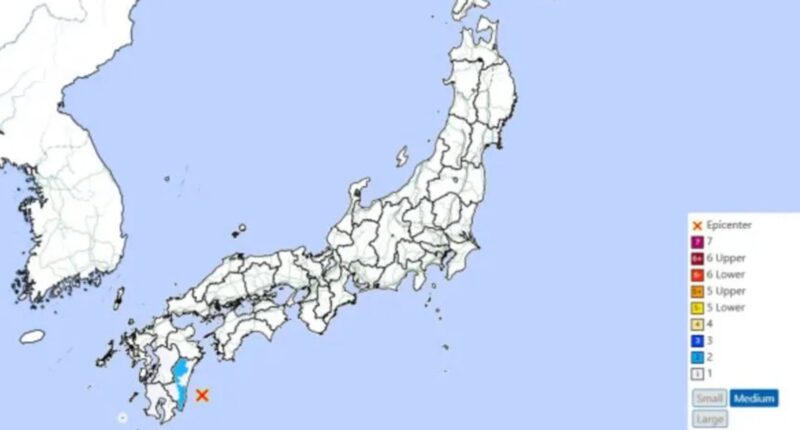JAPAN has issued a tsunami advisory after a magnitude 6.9 earthquake struck the country on Monday.
The quake was at a depth of 23 miles and mainly hit the southwestern Kyushu region, said the European Mediterranean Seismological Centre.


The quake struck at 9.19 p.m. local time, according to the agency.
Tsunami warnings were issued shortly after for Miyazaki Prefecture, where the temblor was centred, in the southwestern island of Kyushu.
A warning was also issued for the nearby Kochi Prefecture.
According to the Japan Meteorological Agency, the tsunami waves could reach up to one metre.
The extent of damage was not immediately clear.
The head of the crisis management department at Takanabe Town Hall in Miyazaki Prefecture, Masamasa Sato, mentioned that the tremor was so intense that standing became challenging for approximately 20 to 30 seconds.
Local authorities are now calling for caution in coastal areas through radio messages.
According to reports from Japanese media, authorities at the Miyazaki Minami Police Station in Miyazaki City, the area affected by the earthquake, have not yet received any calls reporting damage or emergencies.
An officer on duty said: “First there was a small tremor, and then the lateral tremor got bigger and bigger. Nothing fell or anything.”
Japan is frequently hit by earthquakes because of its location along the Ring of Fire, an arc of volcanoes and fault lines in the Pacific Basin.
This region is one of the most geologically active areas on Earth, marked by frequent earthquakes, volcanic eruptions, and tsunamis.
Japan’s geographical location, situated at the convergence of four major tectonic plates – the Pacific Plate, the North American Plate, the Eurasian Plate, and the Philippine Sea Plate – exposes it to a high risk of seismic events and earthquakes.
These plates are constantly shifting and colliding, creating subduction zones where one plate is forced beneath another.
The frequent subduction of plates not only causes earthquakes but also triggers underwater fault movements that can displace large volumes of water, causing tsunamis.
Japan’s location along the coast of the Pacific Ocean makes it especially vulnerable to these devastating waves.
Throughout history, Japan has experienced catastrophic earthquakes and tsunamis.
One of the most significant recent events was the 2011 Tōhoku earthquake and tsunami, caused by subduction along the Japan Trench.
The magnitude 9.1 earthquake triggered massive tsunami waves that devastated coastal areas, leading to the deaths of over 15,000 people and causing the Fukushima nuclear disaster.
Another major earthquake, the 1995 Kobe earthquake, resulted in widespread destruction and the loss of over 6,000 lives.
To mitigate the effects of these natural disasters, Japan has implemented advanced safety measures.
Seismic-resistant buildings are designed to sway rather than collapse during earthquakes, while early warning systems detect seismic activity and provide residents with crucial seconds to prepare.
Along the coast, tsunami defence systems, including sea walls and evacuation plans, aim to minimise casualties.
Education programmes also play a key role in making sure that citizens are prepared for emergencies.
Thesun.co.uk is your go-to destination for the best celebrity news, real-life stories, jaw-dropping pictures and must-see video.

















